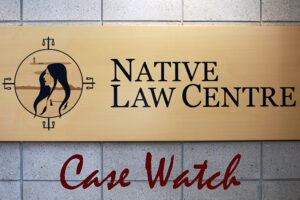The Court struck the pleadings filed by two Wet’suwet’en hereditary chiefs (Dini Ze’) in an action seeking various forms of relief against Canada in relation to federal policy objectives for the reduction of greenhouse gases. It was found to be plain and obvious that the action could not succeed due to insurmountable issues with respect to justiciability, causation, and a lack of specificity regarding alleged constitutional violations.

Indigenous Law Centre CaseWatch Blog
This Statement of Claim is struck without leave to amend, as it is not justiciable, discloses no reasonable cause of action and the remedies are not legally obtainable. The Plaintiff, Dini Ze’ Lho Imggin and Dini Ze’ Smogilhgim on behalf of two Wet’suwet’en House groups of the Likhts’amisyu (Fireweed) Clan: the Misdzi Yikh (Owl House) and Sa Yikh (Sun House), [“Dini Zi’”] put forth this claim related to climate change. The Dini Ze’s position is that Canada’s policy objectives for the reduction of greenhouse gas [“GHG”] emissions by 2030 are insufficient. As a result, they say Canada’s failure to enact stringent legislation is contrary to common law principles of “public trust”, “equitable waste”, and the “constitutional principle of intergenerational equity”.
The Dini Ze argued that there is a violation of their rights under sections 7 and 15(1) of the Canadian Charter of Rights and Freedoms [“Charter”] and that the Charter breaches are not justified under section 1. The Dini Ze’ allege that Canada has breached its duty under section 91 of the Constitution Act, 1867 by not ensuring low GHG emissions under the peace, order and good government [“POGG”] powers. By doing so, Canada is generally violating their constitutional rights by not adhering to international environmental agreements that Canada ratified. Wide ranging remedies are sought including declaratory, mandatory and supervisory orders to keep mean global warming to between 1.5 ̊C and 2 ̊C above pre-industrial level by reducing Canada’s GHG emissions. These reductions relate to Canada’s commitments made in the Paris Agreement.
The Paris Agreement is a multi-national agreement entered into by various nations in order to combat climate change and to work forward to sustain a low-carbon future. The agreement is a hybrid of both legally binding and non-binding provisions. Canada ratified the agreement on October 5, 2016 and the agreement entered into force on November 4, 2016. Canada is one of 189 countries to have ratified the agreement. The Dini Ze’ claim that Canada has repeatedly failed, and continues to fail, to fulfil its duty because they have not implemented the laws, policies, and actions needed to ensure that Canada meets its commitment made in the Paris Agreement to keep mean global warming below 2 ̊C above pre-industrial levels.
Justiciability must involve an action that has subject matter appropriate for a court to decide (Highwood Congregation of Jehovah’s Witnesses (Judicial Committee) v Wall, 2018 SCC 26). The POGG power of the federal government is a tool to facilitate federalism in Canada. It is generally thought of as having three branches: 1) the “gap” branch; 2) the “national concern” branch; and 3) the “emergency” branch (Peter Hogg, Constitutional Law of Canada, 5th ed supplemented (Toronto: Thomson Reuters Canada, 2019)). The POGG powers under section 91 empower the federal Parliament to enact laws in these situations. There is nothing in the law that suggests that it imposes a duty on the government, nor can it force Parliament to enact, change or repeal specific laws in the manner the Dini Ze’ suggests.
The “existence of an article in a treaty ratified by Canada does not automatically transform that article into a principle of fundamental justice” (Kazemi Estate v Islamic Republic of Iran, 2014 SCC 62 [Kazemi]). The only binding international law in a dualist legal system like Canada’s would be a treaty plus conventional law, or proof of applicable customary international law (Nevsun Resources Ltd v Araya, 2020 SCC 5; Kazemi ). Thereby, treaties, such as the Paris Agreement, are only given effect through Canada’s domestic lawmaking process through legislation.
There cannot be a positive duty imposed by international obligations on the peace, order and good government of Canada, as the POGG power has never been used in such a way, and the language of the statute provides that even this novel attempt must fail. When the Dini Ze’ are asking this Court to rule on the constitutionality of the failure to enact what they consider adequate laws to fulfil international obligations, they are really asking the Court to tell the legislature to enact particular laws. This is not the role of the Court and thus not justiciable. Enacting laws is within the jurisdiction of Parliament. If those laws violate the constitution, then there can be striking out, reading down, or reading in of provisions.
With no specific law pointed to, and the broad claims made by the Dini Ze’, it is difficult to find sufficient legal elements in the Charter claims for them to be justiciable. The reason being that there is no impugned law or action to make a comparison necessary to do an analysis under section 1 (R v Oakes, [1986] 1 SCR 103). Complexity itself does not mean that the Court cannot adjudicate an issue; but when the issue spans across various governments, involves issues of economics and foreign policy, trade, and a host of other issues, the courts must leave these decisions in the hands of others. As well, the remedies sought to attempt to simplify a complex situation in a way that would be ineffective at actually addressing climate change given the polycentric and international nature of the problem.
The changes being asked for are more akin to a change in policy than a change in law. In Canada, any real effect on Canada’s GHG emissions will be dependent on the cooperation of the provincial governments. This Court does not have the statutory jurisdiction to mandate any such cooperation between the different levels of government meaning that any remedies would quite possibly be ineffective. This matter is not justiciable as it is the realm of the other two branches of government. This broad topic is beyond the reach of judicial interference. The issue of climate change, while undoubtedly important, is inherently political, not legal, and is of the realm of the executive and legislative branches of government. The Court strikes the claim without leave to amend because of it being plain and obvious that there is no reasonable cause of action (Federal Courts Rules; R v Imperial Tobacco Canada Ltd, 2011 SCC 42).




